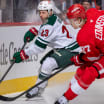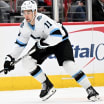FORT LAUDERDALE, Fla. -- The Florida Panthers entered the Eastern Conference Final facing what appeared to be daunting task in trying to solve the New York Rangers penalty kill.
Through the first two rounds of the Stanley Cup Playoffs, the Rangers’ aggressive, pressuring penalty kill was a weapon for them. In addition to killing off 89.5 percent of opponents’ power plays (34 for 38), it scored a League-leading four short-handed goals.
The Panthers have turned that weapon against them, though, in the best-of-7 conference final, which is tied 2-2 with Game 5 at Madison Square Garden on Thursday (8 p.m. ET; ESPN+, ESPN, SN, TVAS, CBC).
Florida has scored five power-play goals -- plus another from Sam Bennett that came three seconds after a power play expired -- in the past three games, including Sam Reinhart’s winning goal in a 3-2 overtime victory in Game 4 on Tuesday that evened the series.
“We’ve been very confident with our power play really all year and it’s nice to see all of them go in,” Panthers forward Matthew Tkachuk said Wednesday. “… Both units are feeling good. A lot of it is just being quick and when we’re quicker, we’re way better.”
Reinhart’s winning goal in Game 4, which came after New York’s Blake Wheeler was called for hooking Aleksander Barkov 59 seconds into overtime, was a perfect example of that. The play, which started when Reinhart won the right circle face-off from Barclay Goodrow and finished on Reinhart’s one-timer from the slot, took only 13 seconds. All five Florida players on the ice touched the puck at least once -- Reinhart, Barkov, Tkachuk, Brandon Montour and Carter Verhaeghe.
“I think it’s just our pace,” said Reinhart, who has three power-play goals in the past two games. “The last couple [games it] has increased, and I think if you look at all these penalty kills that are left, everyone puts that pressure on. So, the more you can withstand that and hold onto a couple pucks, that’s what opens up the middle.”
In addition to passing the puck quickly and accurately, the players were in near constant motion. Reinhart scored the majority of his NHL-leading 27 power-play goals during the regular season on similar one-timers, but he was not in his shooting spot at the inner rim of the right circle until about a second before Barkov fed him with a pass from below the right circle.
Reinhart was above the left circle when Rangers defenseman Jacob Trouba vacated the slot to aggressively pressure Tkachuk when the puck came to him at the right half-wall. Reinhart slid into the opening behind Trouba as Tkachuk passed back to Montour at the point.
Montour followed with a one-touch pass down to Barkov, who made the final quick pass to Reinhart for the one-timed shot in over goalie Igor Shesterkin’s glove.
“We know they play three guys pretty hard on the top [of the penalty kill], which is very effective, and they do a great job at it,” Tkachuk said. “So, just trying to be quick with it and any time you can take it to the net, even on their 5-on-5 defense, man-on-man, you’ve got to do it.
“I thought ‘Barky’ was a great threat down there to take it to the net and then made a great one-touch pass to ‘Reino’ after a few good plays at the top. So, it’s good to get everybody in on that goal.”
The Panthers are 5-for-12 on the power play over the past three games after going 1-for-16 in their previous four. Verheaghe scored from the slot on the power play in Florida’s 2-1 loss in Game 2 and Reinhart scored two power-play goals on backhands from the right side of the net in a 5-4 overtime loss in Game 3.
All three Panthers goals in Game 4 essentially resulted from the power play. Bennett scored at 8:45 of the second period by banking in his own rebound at the left post three seconds after a power play expired. Then, Verhaeghe batted the puck in out of mid-air in front for a power-play goal at 12:16 of the second before Reinhart finished off the rapid-precision passing play 1:12 into overtime.
Each time, the Panthers were able to find an opening to get the puck to the net against the Rangers’ aggressive penalty killers. The key to their approach is pretending they’re still facing five defenders.
“Sometimes you maybe think too much and then it slows you down, but you just need to play the same way as it would be 5-on-5,” forward Anton Lundell said. “Just be quick, be on your toes and ready to attack.”
Of course, the Rangers penalty kill provided a reminder of what can happen when the Panthers don’t maintain their details on the power play with Goodrow’s short-handed goal in Game 3. Still, Florida has won the special teams battle through the first four games by going 5-for-15 (33.3 percent) on the power play with one short-handed goal against while New York is 1-for-11 (9.1).
The Rangers power play showed signs of life in Game 4, though, with Vincent Trocheck scoring on their first opportunity and Mika Zibanejad nearly scoring on their second with a shot that went off the top of goalie Sergei Bobrovsky’s right shoulder before hitting the crossbar.
“I would say their second power play last night did everything but score and ours did,” Panthers coach Paul Maurice said. “So both use hyperaggressive kills and, in order to be successful, you have to get the puck off the wall, and you’ve got to keep it moving. We’ve been pretty good at that.”
Continuing to execute in that way could be a deciding factor in the series, particularly if the Rangers are able to build on their power-play success in Game 4.
“There’s four very strong units: our kill, our power play, their kill, their power play,” Maurice said. “That’s one of the many things that can be the difference. The further you go in, the margin for error is slighter and usually the skill wins out.”



















